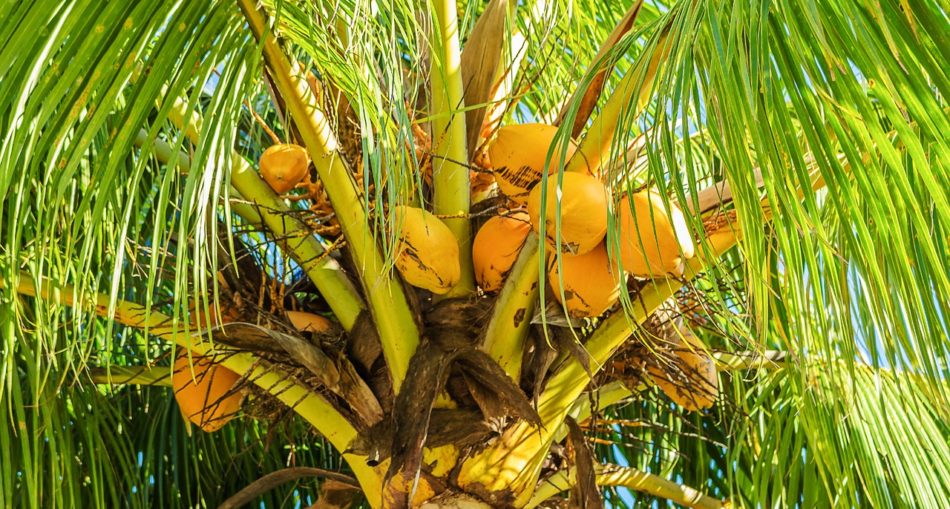Growing up in the countryside of Guyana, the most common plant seen were coconut trees. From our yards to the backdam, these plants dot the landscape of Guyana. Coconut farms are spread across the different regions of the country. It is guaranteed you will see coconut vendors in the city of Georgetown, villages and marketplaces all over Guyana. Many Guyanese opt for a ‘coconut water’ during the many hot days. I’m sure you must have had enjoyed a coconut at least once before, but have you wondered why some of these coconuts look different from each other? It is because they are! More specifically the dwarf coconut is smaller than the nuts from the giant coconut palms and has a wider variety of colours.
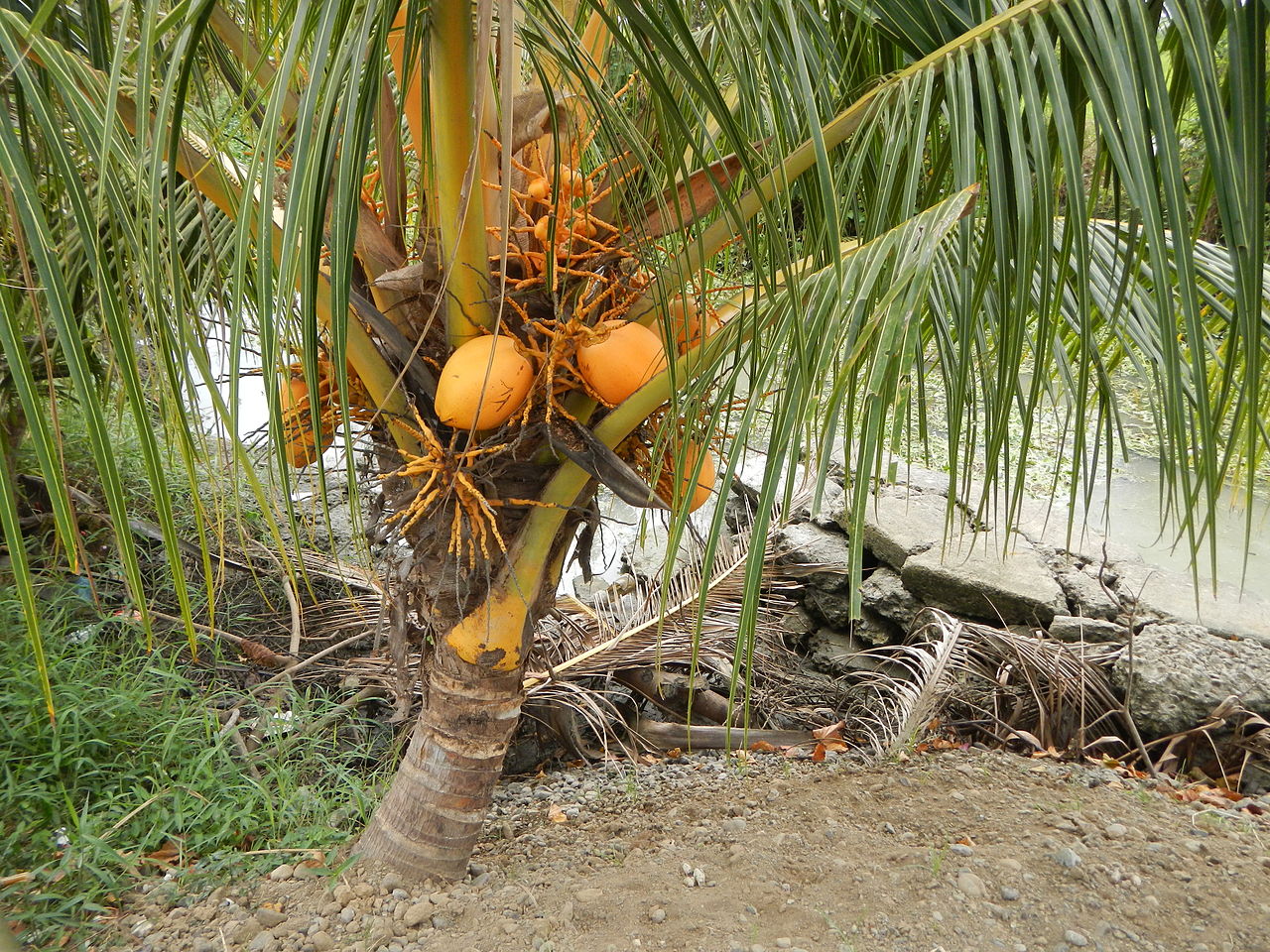
A typical Dwarf Coconut Tree – Image Source: By Judgefloro – Own work, CC BY-SA 4.0, https://commons.wikimedia.org/w/index.php?curid=38401722
The Dwarf Coconut
The only two types of coconut trees are the giant palms and the dwarf palm trees. From the name itself, one can conclude that the dwarf coconut plants are small. You probably do not know that dwarf coconut plants are about six (6) to seven (7) feet tall. Not so tiny, is it? Like the giant coconut type, dwarf coconut trees are also planted for their nutritious, thirst-quenching water and soft, edible flesh. In Guyana, they are referred to as ‘three years’ coconuts. This simply means that they bear fruit about three years after being planted. Dwarf coconut plants have a producing lifespan of about fifty (50) years, compared to the seventy (70) year of the giant coconut trees. These self-pollinating plants, also known by scientific name Cocos Nucifera belong to the family of Arecaceae.
Coconuts grow anywhere in countries of the subtropics and tropics under different climatic conditions and in various soil. The dwarf coconut palms need to be planted in fertile and well-irrigated areas as flooding pose a threat to them. They can still be grown in sandy, saline soils as long as the area gets plenty of sunlight and consistent rainfall. Coconut palms do not need special treatment before planting and can be planted directly into the soil.
Origin of the Dwarf coconut
The origin of the coconut palm has been a controversial topic for many years. The dwarf coconut is native to the Pacific region from which it is said to have originated. In countries like India, Sri Lanka, and the Maldives coconut were also cultivated here though it may have been a different type of coconut palm. You can find the dwarf coconut in countries such as India, Fiji Islands, Philippines, Vietnam, Guyana, Suriname, Brazil and various countries in the Caribbean.
Interesting tip:
- The dwarf coconuts are named by their country of origin and colours e.g. the Malaysian Red Dwarf, Fiji Dwarf Coconuts, Chowghat Dwarf Greens, Cameroon Red Dwarfs and Brazilian Green Dwarfs.
Description of the Dwarf Coconut plants
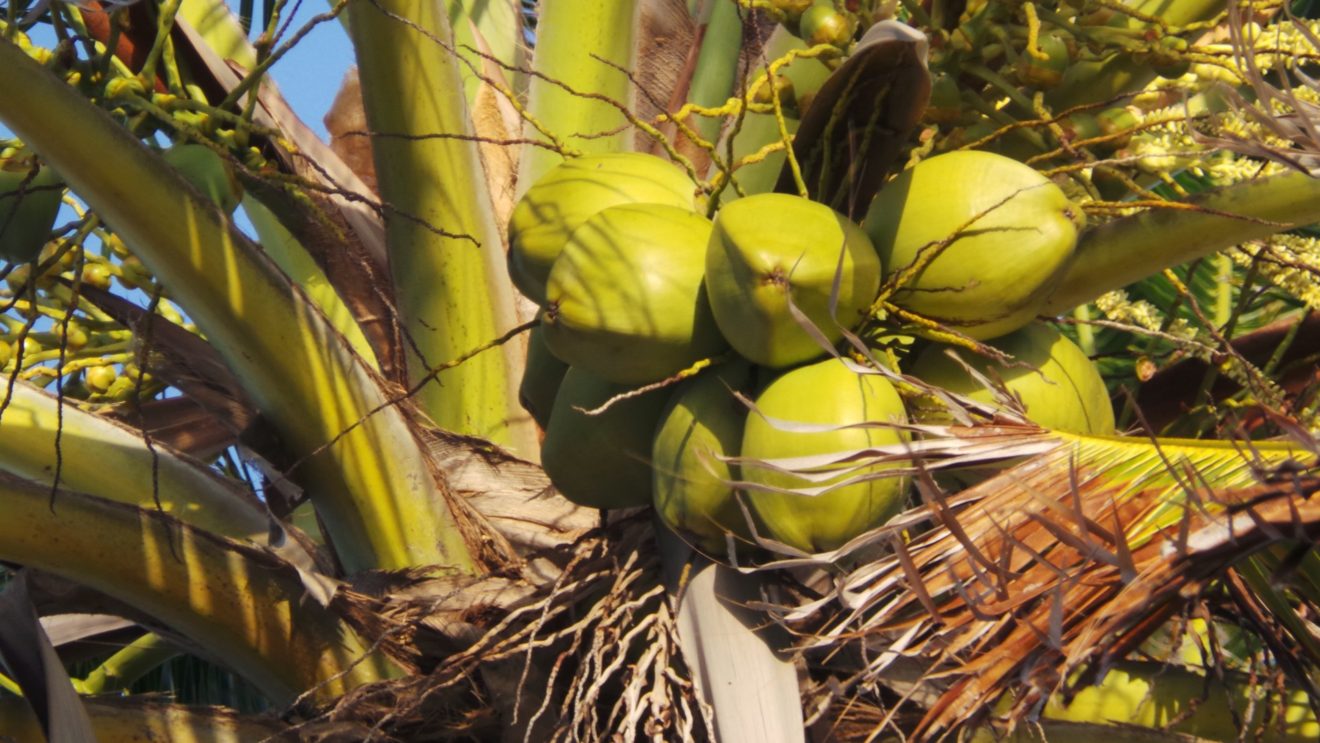
Green Dwarf Coconut- Image Source: https://www.needpix.com/photo/1334306/coco-coconuttree-coconut
A typical dwarf palm has a thick, smooth trunk, anchored by fibrous. These palms are only about three metres in height, even a child can pick the fruits from the tree. Tall green fronds grow in a cluster at the top of the tree. The coconuts hang in bunches from the trees. They share the same characteristics of the tall coconut trees, with the only exception of being miniature.
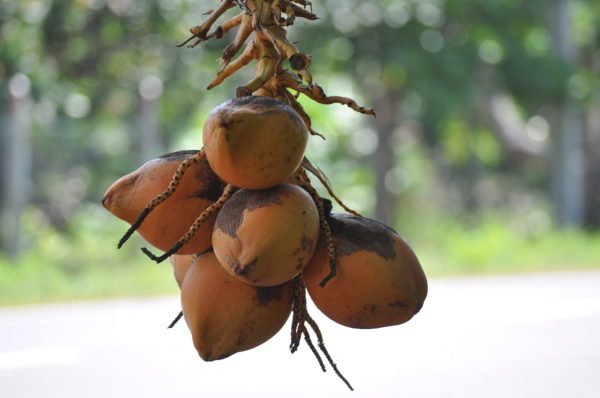
A bunch of Red Dwarf coconuts – Image Source: https://www.needpix.com/photo/1808363/king-coconut-coconut-drinks-fruits-drink-bali-food-fresh-juice
Types of Dwarf Coconut Plants in Guyana
Green Dwarf – similar to the Brazilian Green Dwarf in growth habit, number of nut per bunch and size of nuts.
Yellow Dwarf – has a larger nut size and duller colour in comparison to the Malaysian Yellow Dwarf. Red Dwarf – native to Pomeroon River area and has a reddish colour.
Bronze Dwarf – named for its bronze colour, a new find, reportedly introduced from Suriname.
Interesting tip:
- There is a hybrid of a giant and dwarf coconut trees made by cross-pollination called the ‘Bastard Nut’.
Uses of the Coconut Palms
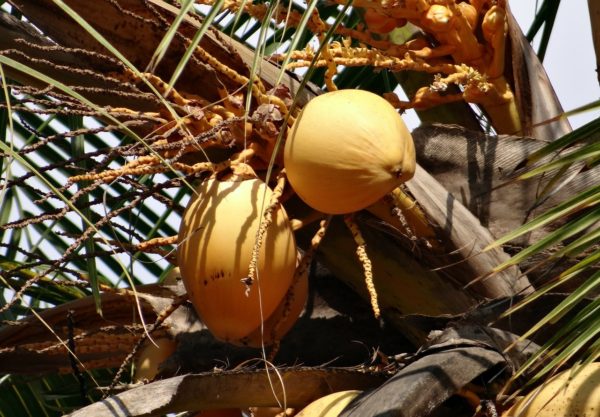
Bronze Dwarf coconuts – Image Source: https://www.needpix.com/photo/168742/coconuts-malayan-cocos-nucifera-coconut-tree-coconut-shell
The Green Dwarf and the Yellow Dwarf coconuts are mainly grown for commercial purposes. In Guyana, the coconut industry is second or well third, only to the rice and sugar industries. Many families depend on the coconut trees to make a living either by selling the coconuts or any of its many byproducts. Coconut palms provide us with:
- Coconuts – from which we get coconut water and jelly, also used to make coconut oil
- Fronds or branches – used to make brooms, toys, roofs, ropes and fans
- Husk – makes charcoal, brushes, mattresses
- Root – used to make mouthwash
To find out more about the products of the coconut tree read one of our previous articles on the Uses of the Coconut tree: https://www.thingsguyana.com/coconut-trees-the-tree-of-a-thousand-uses/
Interesting tip:
- There is only one type of palm plant that produces coconuts, the coconut palm.
- The scientific name of coconut, Cocos Nucifera originated from the Portuguese.
- The word ‘coco’ means face in Portuguese.
- ‘Nucifera’ is Latin for “nut-bearing.”
- Only 5% of the world’s coconut is dwarf coconuts.
Although tiny in stature, these dwarf coconut trees can give the giant ones a run for their money. They start bearing in less time and produce more coconuts than their competition. Their flesh or jelly is sweeter than the normal coconut, while the coconuts themselves provide us with loads of nutrients. If reading this article makes you crave a coconut, go right ahead and indulge yourself because it is a healthy choice. If you’re wondering how different all these coconuts taste, stop at the nearest coconut vendor’s cart and try them for yourself. Maybe you can even check off of tasting all the coconuts in Guyana, on your bucket list.
In case you missed them, read our other articles on the wonders of coconuts:
- Benefits of Coconut water – https://www.thingsguyana.com/coconut-water-benefits-you-didnt-know/
- Uses of the Coconut tree – https://www.thingsguyana.com/coconut-trees-the-tree-of-a-thousand-uses/
Article References:
- https://coconutcloud.net/blogs/coconut-cloud/where-do-coconuts-come-from
- http://guyanachronicle.com/2016/11/05/four-main-varieties-of-coconuts-used-for-commercial-purposes-locally
- https://living.thebump.com/plant-dwarf-coconut-trees-8343.html
- http://www.cardi.org/wp-content/uploads/downloads/2013/08/Producing-coconuts-using-the-dwarf-plant.pdf
- https://www.nature.com/articles/192085a0
- https://source.wustl.edu/2011/06/deep-history-of-coconuts-decoded/
- http://newsaboutbananas.blogspot.com/2014/04/where-did-coconut-originate.html
- https://www.cardi.org/commodities-themes-2/coconuts7/
- https://coconuthandbook.tetrapak.com/chapter/plantation
- https://www.usesofcoconut.com/coconut-leaves/

